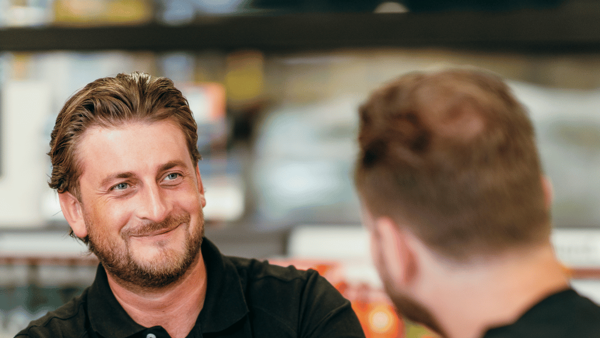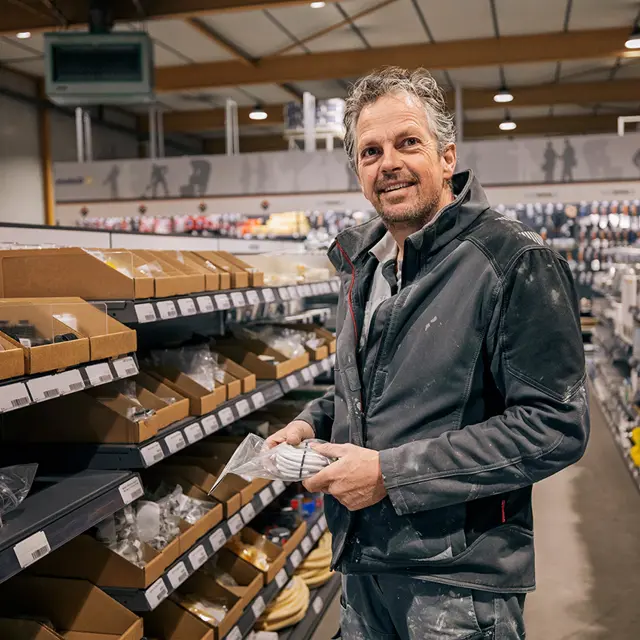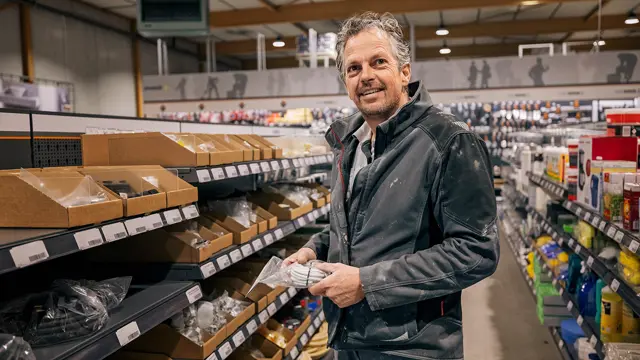Cases
This is how HSO helps customers achieve better results.
"We want more building power for our builders"
The Stiho Group (DSG) is a leading wholesaler and construction supplier, active in the supply of building materials to professional contractors.... A key pillar of DSG's strategy is to help customers increase their construction capability.

That means DSG wants to take care of as many peripheral issues for customers as possible, so they can do what they love most: build. To do that, it is essential to know customers well. A full 360° customer view, knowing who the customer is, what's going on and through which channel they are in contact, is essential to this. To achieve this, DSG replaced the old CRM system for a modern, integrated solution based on Microsoft Dynamics 365. Together with HSO.
Marieke Zijlstra is Product Owner at DSG and tells more about this project.
Why did you want a new CRM?
"The impetus came from a broad strategic question: how do we want to connect with our customers in the future? We saw that our customers, contractors, furniture makers, construction professionals, increasingly need speed, convenience and personal contact. We wanted to respond to that. So the desire was not simply: we need a new system. No, it was about the question: what is needed to serve our customers better and support our employees better in doing so? A modern CRM solution was a logical consequence of that."
What exactly do you mean "more building power" for the customer?
"More construction capability is at the heart of our new brand positioning," explains Marieke. "Our clients often have complex projects, with many peripheral issues: procurement, logistics, regulations. We want to make sure they can concentrate on what they are good at: building."
"Our job is to make those peripheral issues easier. So when a customer calls, we want the employee to immediately see: what's going on with this customer? Are there pending quotes, open service requests, recent returns? In our old system, that wasn't possible. Employees often knew a lot because they knew the customer well, but that's not scalable. We wanted everyone to have the same 360° customer view at a glance."
What does that 360° customer view look like in practice?
"That starts with recognition," says Marieke. "When a customer calls, or stands at the counter, we now immediately see who it is, what's going on and what the last interactions have been. But it goes further. For example, we can see that a customer always buys certain materials from us, but not the finishing materials that logically go with them. That creates opportunities for better advice and cross-sell. The conversation becomes more relevant, personal and professional."
"Marketing and sales also benefit from this. Our marketing campaigns are now linked to the CRM data, allowing us to communicate in a more targeted way. Everything comes together in one environment."


How did you come to HSO?
"Once we were clear about what we were looking for in a new CRM, we started working with an external consultant," says Marieke. "He helped us make a shortlist of suitable packages and implementation partners. HSO emerged from that as a party with a lot of experience in our market and in Microsoft Dynamics."
"After the selection, we started a Discovery phase. That was incredibly valuable," she continues. "Together with HSO we divided our requirements into logical parts - marketing, sales, service - and for each part we looked at what we wanted to achieve and which systems were affected. This was new territory for us, so that guidance was important. In a few months, we created the blueprint for the first release with key users. Then we delivered in five releases, and by April 2025 the project phase was complete. Meanwhile, we continue to work in a management and development contract with HSO, so that we continuously improve the platform."


How do you look back on the implementation process?
"What I found strong is that HSO really put the user first, and didn't just take technology as the starting point" says Marieke. "They introduced us to the Prosci ADKAR methodology, which guides change step by step. In two sessions, our management was taken through how you bring people along in change. That gave us something to hold on to. We then rolled out the method further in the organization, so that we could monitor whether everyone was sufficiently involved and ready for the next step.
"The collaboration was very pragmatic: we determined each time what we wanted to achieve and what was needed to do so. First we cut the project into logical parts, then we dived into depth for each part - together with the key users. Together with the architects on both sides, we regularly looked at how the lines should run: what is already possible, and what is not yet possible? For the integrations, HSO also actively thought along with us about what was relevant and how we could best approach it."


What has the new solution brought you so far?
"The biggest difference is in insight and efficiency," says Marieke. "Employees now see immediately who is calling, what is going on and the status of pending matters. That makes conversations smoother and more personal. We can greet customers by name, but also immediately respond to what's going on, such as a return or just a new quote."
"In addition, dashboards in Dynamics help us to steer rather than react. Before, the work mostly came at you; now you can see at a glance what has priority and where action is needed. The quotation process is also tighter, with clear process steps and approvals. As a result, we work more consistently and faster. And with the link to marketing automation, we can approach customers in a more targeted way based on up-to-date data."
"Figures are still difficult because we have only been live for a year with the first release. But the first signs are positive: customer satisfaction remains up to par and employees experience more structure and overview."
What's next for DSG?
"We continue to improve continuously," says Marieke. "Now that the basis is in place, we are focusing on further optimization: making processes smarter. We are also linking more and more teams to the system so that information can be shared more quickly. This allows us to help our customers even better, which is ultimately what it's all about."
"AI and automation are coming, but our goal is primarily to keep our processes running smoothly. If that means AI helps us do that, then we are open to that. But the core remains: we want to give our customers more building power so they can do what they do best. We make sure everything around it runs smoothly."
Cases
This is how HSO helps customers achieve better results.
Do you also want to give your clients the space to do what they do best?
We, and third parties, use cookies on our website. We use cookies to keep statistics, to save your preferences, but also for marketing purposes (for example, tailoring advertisements). By clicking on 'Settings' you can read more about our cookies and adjust your preferences. By clicking 'Accept all', you agree to the use of all cookies as described in our privacy and cookie policy.
Purpose
This cookie is used to store your preferences regarding cookies. The history is stored in your local storage.
Cookies
Location of Processing
European Union
Technologies Used
Cookies
Expiration date
1 year
Why required?
Required web technologies and cookies make our website technically accessible to and usable for you. This applies to essential base functionalities such as navigation on the website, correct display in your internet browser or requesting your consent. Without these web technologies and cookies our website does not work.
Purpose
These cookies are stored to keep you logged into the website.
Cookies
Location of Processing
European Union
Technologies Used
Cookies
Expiration date
1 year
Why required?
Required web technologies and cookies make our website technically accessible to and usable for you. This applies to essential base functionalities such as navigation on the website, correct display in your internet browser or requesting your consent. Without these web technologies and cookies our website does not work.
Purpose
This cookie is used to submit forms to us in a safe way.
Cookies
Location of Processing
European Union
Technologies Used
Cookies
Expiration date
1 year
Why required?
Required web technologies and cookies make our website technically accessible to and usable for you. This applies to essential base functionalities such as navigation on the website, correct display in your internet browser or requesting your consent. Without these web technologies and cookies our website does not work.
Purpose
This service provided by Google is used to load specific tags (or trackers) based on your preferences and location.
Why required?
This web technology enables us to insert tags based on your preferences. It is required but adheres to your settings and will not load any tags if you do not consent to them.
Purpose
This cookie is used to store your preferences regarding language.
Cookies
Why required?
We use your browser language to determine which language to show on our website. When you change the default language, this cookie makes sure your language preference is persistent.
Purpose
This service is used to track anonymized analytics on the HSO.com application. We find it very important that your privacy is protected. Therefore, we collect and store this data anonymously on our own servers. This cookie helps us collect data from HSO.com so that we can improve the website. Examples of this are: it allows us to track engagement by page, measuring various events like scroll-depth, time on page and clicks.
Cookie
Purpose
With your consent, this website will load Google Analytics to track behavior across the site.
Cookies
Purpose
With your consent, this website will load the Google Advertising tag which enables HSO to report user activity from HSO.com to Google. This enables HSO to track conversions and create remarketing lists based on user activity on HSO.com.
Possible cookies
Please refer to the below page for an updated view of all possible cookies that the Google Ads tag may set.
Cookie information for Google's ad products (safety.google)
Technologies Used
Cookies
Purpose
With your consent, we use IPGeoLocation to retrieve a country code based on your IP address. We use this service to be able to trigger the right web technologies for the right people.
Purpose
With your consent, we use Leadfeeder to identify companies by their IP-addresses. Leadfeeder automatically filters out all users visiting from residential IP addresses and ISPs. All visit data is aggregated on the company level.
Cookies
Purpose
With your consent, this website will load the LinkedIn Insights tag which enables us to see analytical data on website performance, allows us to build audiences, and use retargeting as an advertising technique. Learn more about LinkedIn cookies here.
Cookies
Purpose
With your consent, this website will load the Microsoft Advertising Universal Event Tracking tag which enables HSO to report user activity from HSO.com to Microsoft Advertising. HSO can then create conversion goals to specify which subset of user actions on the website qualify to be counted as conversions. Similarly, HSO can create remarketing lists based on user activity on HSO.com and Microsoft Advertising matches the list definitions with UET logged user activity to put users into those lists.
Cookies
Technologies Used
Cookies
Purpose
With your consent, this website will load the Microsoft Dynamics 365 Marketing tag which enables HSO to score leads based on your level of interaction with the website. The cookie contains no personal information, but does uniquely identify a specific browser on a specific machine. Learn more about Microsoft Dynamics 365 Marketing cookies here.
Cookies
Technologies Used
Cookies
Purpose
With your consent, we use Spotler to measures more extensive recurring website visits based on IP address and draw up a profile of a visitor.
Cookies
Purpose
With your consent, this website will show videos embedded from Vimeo.
Technologies Used
Cookies
Purpose
With your consent, this website will show videos embedded from Youtube.
Cookies
Technologies Used
Cookies
Purpose
With your consent, this website will load the Meta-pixel tag which enables us to see analytical data on website performance, allows us to build audiences, and use retargeting as an advertising technique through platforms owned by Meta, like Facebook and Instagram. Learn more about Facebook cookies here. You can adjust how ads work for you on Facebook here.
Cookies
Purpose
With your consent, we use LeadInfo to identify companies by their IP-addresses. LeadInfo automatically filters out all users visiting from residential IP addresses and ISPs. These cookies are not shared with third parties under any circumstances.
Cookies
Purpose
With your consent, we use TechTarget to identify companies by their IP address(es).
Cookies
Purpose
With your consent, we use this service provided by uMarketingSuite to run A/B tests across the HSO.com application. A/B testing (also called split testing) is comparing two versions of a web page to learn how we can improve your experience.
Purpose
With your consent, we use this service provided by uMarketingSuite to personalize pages and content across the HSO.com application. Personalization helps us to tailor the website to your specific needs, aiming to improve your experience on HSO.com.
Purpose
With your consent, we use ZoomInfo to identify companies by their IP addresses. The data collected helps us understand which companies are visiting our website, enabling us to target sales and marketing efforts more effectively.
Cookies